Sunday’s Full Flower Moon Eclipsed, Morning Mars Moves Past Neptune, and Moonless Evenings Grow Globular Clusters!
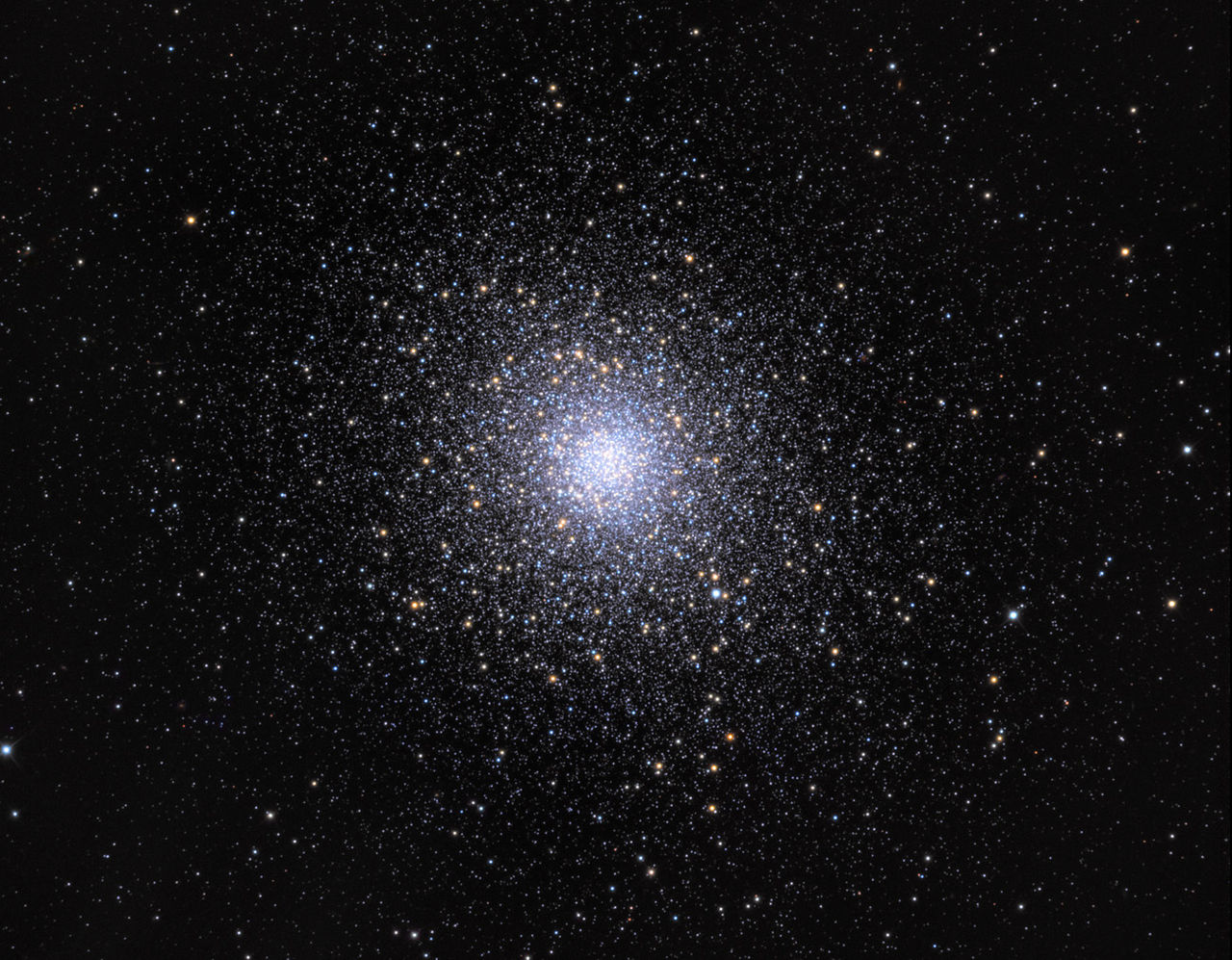
This image of the big and bright globular star cluster Messier 5 in Serpens was captured by Adam Block at Mount Lemmon Sky Center, University of Arizona. The image covers about 20 arc-minutes of the sky, left-to-right. Note the old yellow stars sprinkled throughout.
Hello, Mid-May Stargazers!
Here are your Astronomy Skylights for the week of May 15th, 2022 by Chris Vaughan. Feel free to pass this along to your friends and send me your comments, questions, and suggested topics. You can also follow me on Twitter as @astrogeoguy! Unless otherwise noted, all times are expressed in Eastern Time. To subscribe to these emails please click this MailChimp link.
If you’d like me to bring my Digital Starlab portable inflatable planetarium to your school or other daytime or evening event, or deliver a session online, contact me through AstroGeo.ca, and we’ll tour the Universe, or the Earth’s interior, together! My terrific new book with John A. Read entitled 110 Things to See With a Telescope is a guide to viewing the deep sky objects in the Messier List – for both beginners and seasoned astronomers. DM me to order a signed copy!
During the total lunar eclipse on Sunday night in the Americas, the moon will reach its Full Moon Phase. For the rest of the week, the moon will wane and rise later, leaving evening skies worldwide dark enough to enjoy globular star clusters. Meanwhile, the eastern morning sky will host four bright planets, Neptune, and the main belt asteroid Vesta. For several mornings surrounding Wednesday, Mars and Neptune will be telescope-close! Read on for your Skylights!
The Moon
Tonight (Sunday), the moon will traverse Earth’s shadow, producing a total lunar eclipse between 10:28 pm and 1:56 am EDT (or 02:28 to 05:56 Greenwich Mean Time). I wrote about it in detail last week here, including a map of where it will be visible. Observers in the Central Time Zone should subtract one hour from those Eastern Times. Those in the Mountain Time and Pacific Time zones, should subtract two and three hours, respectively. Totality will occur between 11:29 pm and 12:54 am EDT (or 03:29 to 04:54 GMT). With a duration of 85 minutes, this will be a very deep and lengthy total lunar eclipse – with the moon’s northern edge skimming the centre of Earth’s umbra.
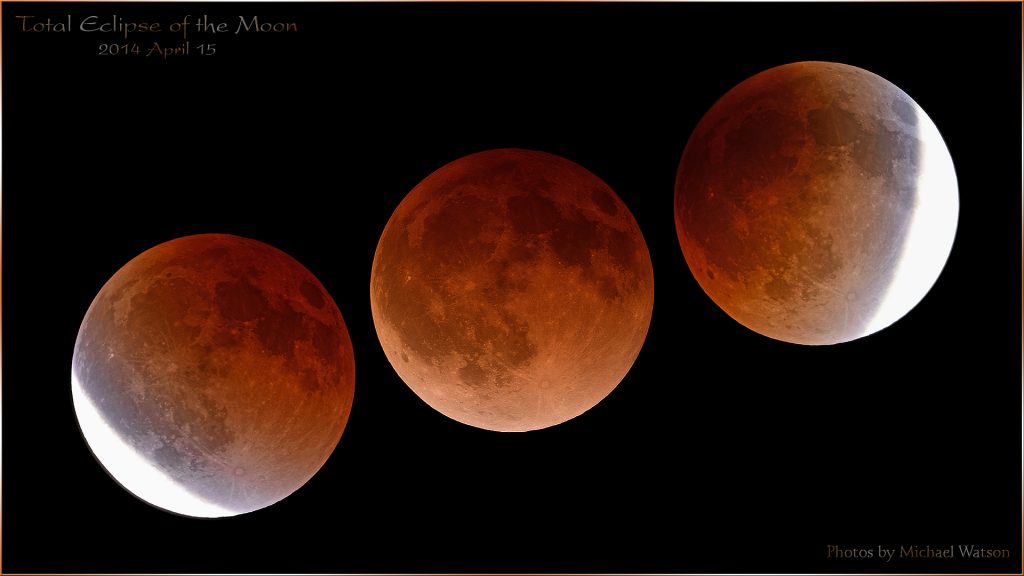
The moon will already be almost entirely darkened and reddened within the umbra when it rises for observers west of Saskatoon in Canada and Las Vegas in the USA. Lunar eclipses are completely safe to observe with your unaided eyes, binoculars, and telescopes – but you will need clear skies to see it. If it’s cloudy where you are, tune in to a live stream on YouTube. Fair warning though – lunar eclipses are slow affairs, so you may want to watch a stream in Fast-Forward! Good luck, and tag me if you take pictures!
The moon will officially reach its full phase during mid-eclipse at 12:14 am EDT (or 04:14 GMT) on Monday, May 16. May’s full moon always shines in or near the stars of Libra (the Scales) or Scorpius (the Scorpion). Every culture around the world has developed its own stories about the full moon, and has assigned special names to each full moon. The indigenous Ojibwe groups of the Great Lakes region call the May full moon Zaagibagaa-giizis “Budding Moon” or Namebine-giizis, the “Sucker Moon”. For them it signifies a time when Mother Earth again provides healing medicines. The Cree of North America call it Athikipisim, the “the Frog Moon” – the time when frogs become active in ponds and swamps. The Cherokee call it Ahnisguti, the “the Planting Moon”, when the fields are plowed and sown. In the Mi’kmaq lunar calendar, this is Etquljewiku, the Frog-Croaking Moon. In European cultures, the moon is commonly called the Full Milk Moon, Full Flower Moon, or Full Corn Planting Moon. When fully illuminated, the moon’s geology is enhanced – especially the contrast between the bright, ancient, cratered highlands and the darker, younger, smoother maria.
For the rest of this week, the moon will wane in illuminated phase and rise later each night. On Monday night, watch for the very bright, reddish star Antares, the heart of the scorpion, shining to the moon’s lower right. From Tuesday to Thursday, the moon will trek through Ophiuchus (the Serpent-Bearer) and the teapot-shaped stars of Sagittarius (the Archer). Early risers can see that waning gibbous moon in the lower part of the southern sky beyond sunrise on Friday morning.
On the coming weekend, the moon will shine near the yellowish dot of Saturn in Capricornus (the Sea-Goat) – shining 1.4 fist diameters to the ringed planet’s lower right on Saturday and a few finger widths below Saturn on Sunday morning. For the best views, or a photo opportunity, try to catch them between about 3:30 am local time and dawn. The moon will officially reach its third quarter phase at 2:43 pm EDT or 18:43 GMT on next Sunday afternoon in the Americas. The week of dark, moonless evening skies that follow this phase are the best ones for observing deep sky targets.
The Planets
With Mercury now lost from view in the western post-sunset twilight, there are no planets to observe in the evening sky. The planet party is happening in the southeastern sky during hours before sunrise! This week, the small yellow dot of Saturn will appear above the treetops towards the east-southeast sometime after 3 am local time. About 75 minutes later, Mars’ little reddish dot will appear about three fist diameters to Saturn’s lower left (or 30° to the celestial east). Much brighter Jupiter will join the fun just a few minutes later. By 5 am local time, the brightest planet, Venus, will round out the lengthy chain of planets. Fainter Saturn and Mars will fade into the brightening sky towards sunrise.
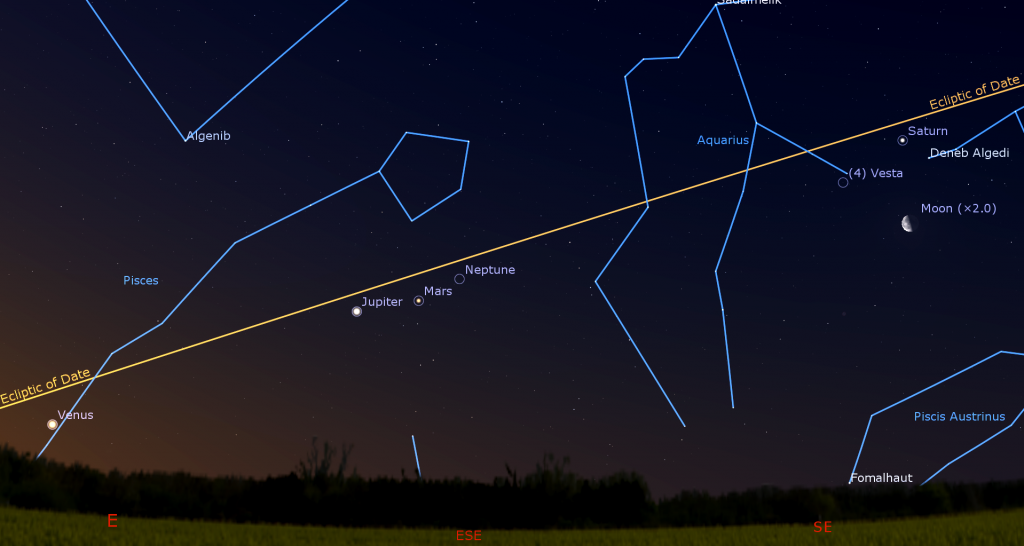
If you watch those planets this week, you’ll note that Mars will slide closer to more distant Jupiter. Venus’ sunward swing will widen its separation from the other planets. During this week the main belt asteroid named (4) Vesta will be passing several finger widths below and to the left (or 3.5° to the celestial southeast) of Saturn – but you’ll need good binoculars or a backyard telescope to see its magnitude 7.3 speck. Mars will scoot past 730 times fainter Neptune on Wednesday morning. Those two planets, one red, one blue, will share the view in a backyard telescope from Tuesday to Thursday. The conjunction will be more easily seen by observers at southerly latitudes, where the planets will sit higher in a darker sky.
Any size of telescope will show you Saturn’s full globe, its rings, and a few of its moons. Venus will exhibit a football-shape in a backyard telescope or in good binoculars. Mars will exhibit a tiny, 88%-illuminated disk. Jupiter will also get a little higher and farther from the sun with each passing day, allowing you to enjoy its dark equatorial bands, Great Red Spot (with the small black dot of Europa’s shadow superimposed on it on Monday, and Saturday morning), and its four Galilean moons. Turn all optics away from the east before sunrise, please!
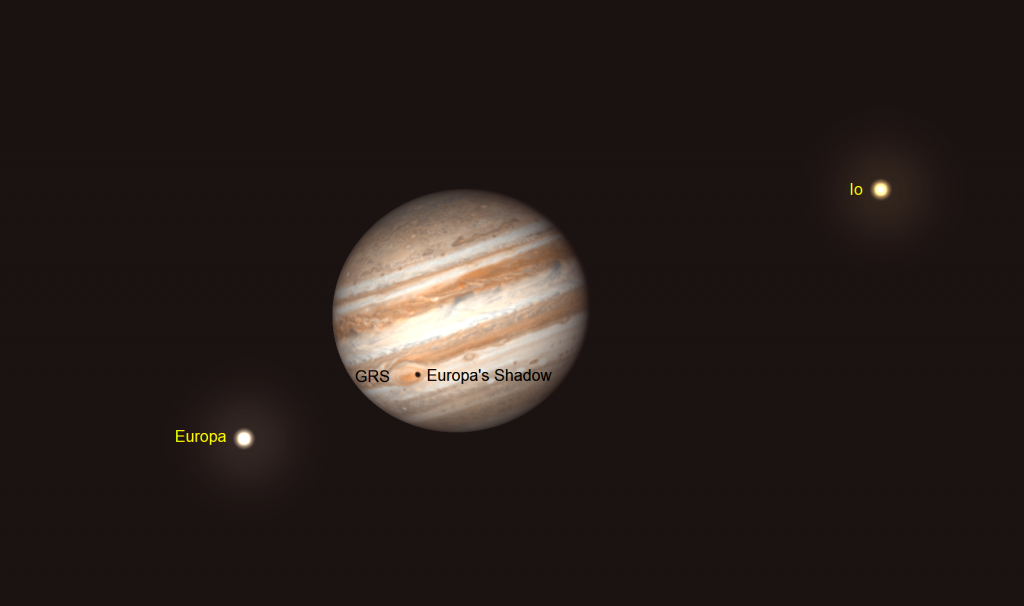
Wondering about Uranus? That planet will become visible in the pre-dawn sky after a meet up with Venus on June 11.
Globular Clusters
During May, the best globular star clusters observable from mid-northern latitudes become well-placed in the eastern evening sky. Globular star clusters, or globulars, are densely packed, spherical concentrations of old stars that orbit our galaxy’s core – but mainly outside of the galaxy’s disk. Containing hundreds of thousands to millions of stars, they might even be the cores of former galaxies that our Milky Way’s gravity has stripped the gas and dust out of.
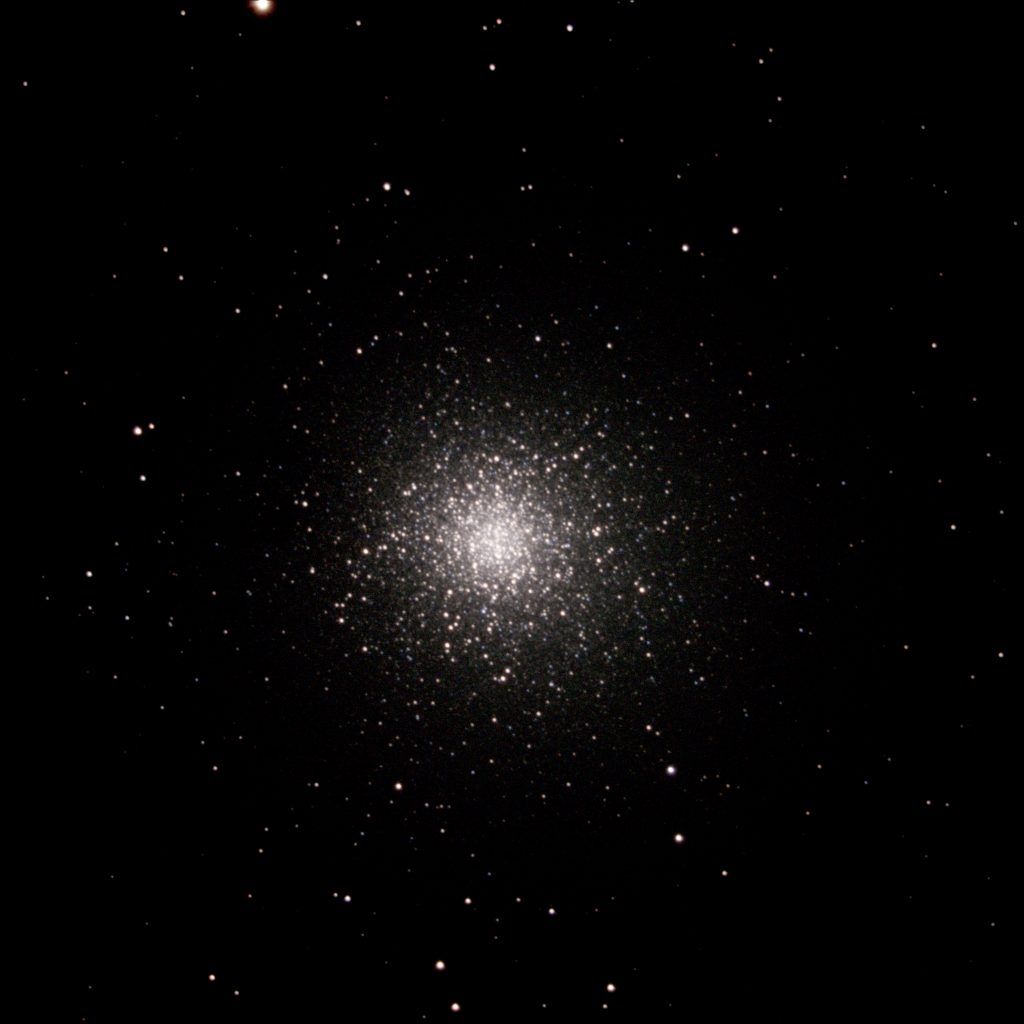
This kind of deep sky object is generally bright enough to see under mildly light-polluted skies. In binoculars they’ll appear as a fuzzy, grey star. In a backyard telescope, they look like sugar or salt spilled on a velvet cloth. The closer ones are larger and brighter.
In early evening, face southeast and look for 7.7 magnitude Messier 53 (or M53) in Coma Berenices (Berenice’s Hair) and the spectacular magnitude 6.2 globular named Messier 3 (M3) in Canes Venatici (the Hunting Dogs). M53 is located just to the left of the medium-bright star Diadem, and M3 is located a fist’s diameter above the very bright star Arcturus. A bright, magnitude 6.5 one named Messier 5 lies in Serpens Caput (the Snake’s Head), 2.3 fist diameters below (or 23° southeast of) Arcturus. It is approximately 24,500 light-years away from us.
As the evening wears on, the constellation of Hercules will be carried higher. It hosts two terrific globulars. Messier 92 shines at an easy magnitude 6.5. The brightest one in our skies – the Great Hercules Cluster, aka Messier 13 gleams at magnitude 5.8. All of these objects will reach their highest altitudes and best appearance, in the hours after midnight.
Many more globular clusters populate Ophiuchus (the Serpent-Bearer) and Scorpius (the Scorpion).
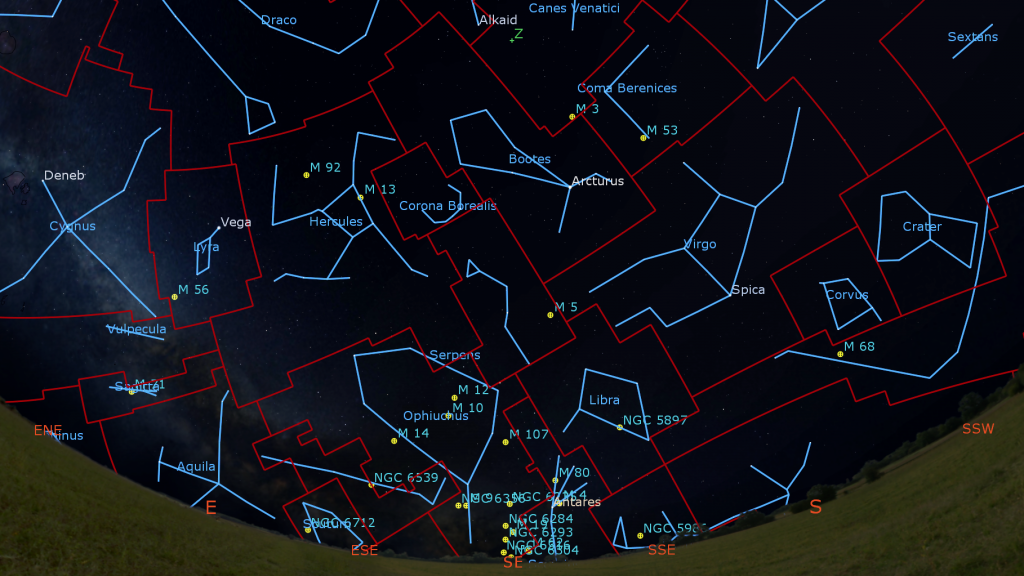
Public Astro-Themed Events
Every Monday evening, York University’s Allan I. Carswell Observatory runs an online star party – broadcasting views from four telescopes/cameras, answering viewer questions, and taking requests! Details are here. They host in-person viewing on the first clear Wednesday night each month. Other Wednesdays they stream views online via the observatory YouTube channel. Details are here.
While you are waiting for the lunar eclipse tonight (Sunday evening, May 15), join Space Place Canada for a free online talk by the terrific Dr. Sara Mazrouei, Educational Developer at Toronto Metropolitan University’s Centre for Excellence in Learning and Teaching. A moon expert by training, her topic will be Lunar Exploration: Past, Present, and Future. The registration link for free tickets and more details are available here.
On Tuesday night, May 17 from 8 to 9 pm EDT, SkyNews Magazine editor Allendria Brunjes and Canadian astrophotographer Paul Owen will host Subs and Stars – the final session of their free, eight-part online series on astrophotography. This session will cover processing of globular cluster images collected by RASC’s Robotic Telescope. Details are here, and the Zoom registration link is here.
On Wednesday evening, May 18 at 7 pm, the Perimeter Institute in Waterloo will present a free public talk and webcast by Dr. Katie Mack. From June 2022 she will be the Hawking Chair in Cosmology and Science Communication at the Perimeter Institute for Theoretical Physics. She is the author of the fantastic book “The End of Everything (Astrophysically Speaking)”, and has written for a number of popular publications, such as Scientific American, Slate, Sky & Telescope, Time, and Cosmos magazine. Dr. Mack will speak about Physics at the End of the Universe. Registration and details are here.
On Wednesday evening, May 18 at 7:30 pm EDT, the RASC Toronto Centre will live stream their monthly Speakers Night meeting. This month will feature Dr. Laurie Rousseau-Nepton, resident astronomer at the Canada-France-Hawaii Observatory. Her talk is titled SIGNALS: Learning about the Birth of Stars with SITELLE. Everyone is invited to watch the presentation live on the RASC Toronto Centre YouTube channel. Details are here.
On Thursday evening, May 19, join Space Place Canada for a free online talk by Canadian author and journalist Elizabeth Howell titled Canadarm and Collaboration, about how Canadian astronauts support the International Space Station. The registration link for free tickets and more details are available here.
RASC’s public sessions at the David Dunlap Observatory may not be running at the moment, but they are pleased to offer some virtual experiences instead in partnership with Richmond Hill. The modest fee supports RASC’s education and public outreach efforts at DDO.
On Friday night, May 20 from 9 to 10:30 pm EDT, tune in for DDO Up in the Sky. During the family-friendly session, RASC astronomers will live-stream views through their telescopes and the giant 74” telescope at DDO (pre-recorded views will be used if skies are cloudy). Only one registration per household is required. Deadline to register for this program is Wed., May 18, 2022 at 3 pm. Prior to the start of the program, registrants will be emailed the virtual program links. More information is here and the registration link is here.
My free, family-friendly Insider’s Guide to the Galaxy webcasts with Samantha Jewett of RASC National returns on Tuesday, May 24 at 3:30 pm EDT, when we’ll discuss how to prepare for an evening of stargazing – cloud forecasts, equipment preparation, target selection, etc. Plus, we’ll continue with our Messier Objects observing certificate program and share some galaxy-viewing tips. You can find more details and the schedule of future sessions here.
Don’t forget to take advantage of the astronomy-themed YouTube videos posted by RASC Toronto Centre and RASC Canada.
Keep looking up, and enjoy the sky when you do. I love questions and requests. Send me some!